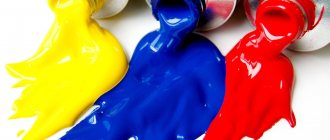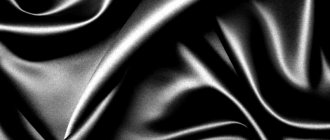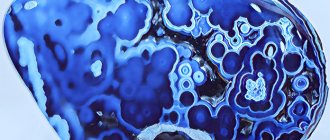Greetings, friends!
Purple is the most mystical of all colors. Already in ancient times, people saw in it some kind of magical attraction. This color was chosen by sages and magicians for their robes; it denoted everything mysterious and veiled. Even the starry sky is sometimes depicted as purple to give it mysticism and mystery. Today we will talk about how the color purple affects the human psyche, what it is associated with and what can be said about people who prefer things of this color.
General value
Purple is a mixture of two opposites, bright red, associated with passion, and cool, rational blue. It is the fact that it was created in contrast that is the reason that the color purple is interpreted ambiguously in psychology. It is rarely found in wildlife, so people began to use lilac pigment only at the beginning of the 19th century.
If a person chooses this complex tone as the dominant one, then this speaks of the complexity and contradictory nature of his nature. On the one hand, he is burning with passion, ready for active action. But on the other hand, he is a closed and often insecure person who requires the protection and support of loved ones. An internal struggle with oneself is how one can characterize the behavior style of this person. A passionate nature comes into conflict with a cold mind, which is why a person will often be faced with a lack of understanding of what he should do.
To understand what the color lilac means in psychology, you should pay attention to its shade, understand what predominates in it - warm red or cold blue. Main interpretation options:
- Dominance of red tone. It says that a person is infantile, vulnerable, and often lives in the past. His psyche is not yet fully formed.
- Predominance of blue. Characterizes an overbearing selfish person for whom it is almost impossible to achieve normal relationships with family and work colleagues.
- Delicate light shades (lilac, lavender, lilac) reveal a creative nature, for which solving material and everyday problems is a real punishment. Such people are very attached to their family members, and separation from them is difficult.
The meaning of purple in psychology may also be associated with a mystical component. Often people who unconsciously choose it as dominant believe in otherworldly forces and are passionate about everything mysterious that is in the world. These are dreamers floating in the clouds who perceive the world around them in such an original way that they often remain misunderstood.
In a woman’s psychology, the color purple means pregnancy, and she herself may not even be aware of her situation. Additional shades of meaning:
- Excessive care for children. A woman who prefers this color scheme takes care of her sons and daughters so much that she prevents them from establishing their own lives.
- Naivety, infantilism. Often the shade speaks of the immaturity of the psyche of its admirer, her inability to make decisions and bear responsibility for them.
- Gentleness, willingness to give in.
- Calm friendly disposition.
Very often it is chosen by young girls who are still searching for their path in life. Sometimes they are not independent, often fall under the influence of stronger and more integral individuals, and prefer to obey rather than dominate.
Lilac color in psychology is considered as a muted shade of purple. It is often preferred by artists and actors, people who see the world from a different angle than most. These are owners of unconventional thinking, whose talent often compensates for the lack of practicality. They can achieve significant success, but only with the help of more pragmatic and self-confident partners.
Localization of purple color
Violet color can be used to color both the entire human aura and part of it. In addition, the accumulation of one or another shade can be observed in the area of certain organs and chakras, for example:
- left side – difficulties in human interaction with the outside world;
- right side - the dull color of the aura indicates a lack of vital energy, slow metabolism in the body, and a bright tone has the opposite meaning;
- head area – developed intuition, clarity of mind, high intellectual abilities;
- area of the heart – sensitivity of nature, indifference to intimacy.
Identified negative aspects in the body’s functioning can be eliminated by performing energy practices.
Use in practice
Color therapy is a popular direction used in therapy. Purple color for women in psychology has a whole range of beneficial effects, helping to cope with many problems. Main impacts:
- Improves vision.
- Helps cope with stress, nervous shock, restore inner peace and harmony with oneself.
- Reduces blood pressure.
- Increases self-esteem.
- Relieves anxiety.
- Used for phobias to combat panic attacks.
- Improves the ability to concentrate.
In addition, the color purple is used in psychology to work with pregnant women. It helps improve her well-being and is useful for the normal development of the fetus. It is believed to stimulate the development of intuition. If a person cannot solve some complex issue, it is this shade that will allow him to find a way out and lead to sudden insight.
Purple aura color - impact on health
People with a violet aura cannot boast of good physical health. They often experience malaise, general weakness and lack of vitality. Mental health is also often at risk.
Such individuals need to learn to relax, stop taking everything to heart and obsessing over their own failures.
The location of the violet color on the aura will tell you more about your health status. In other words, you should take into account which organ has the greatest accumulation of color.
Depending on the shade, you can recognize the presence of diseases or imminent changes that will occur in the body. For example, dark tones often indicate problems with a particular organ or the development of a serious disease.
It should be noted that the meaning of the violet aura in men and women is somewhat different. For men, it often has a negative interpretation - mental problems, sexual disorders, infertility, emotional exhaustion.
The purple color of the energy biofield in women may indicate early pregnancy, especially if its accumulation is observed in the abdominal area. The presence of dark stains on a purple background indicates a lack of nutrients for the normal functioning of a particular organ.
Meaning in clothing, interior
Considering who loves the color purple in psychology, researchers note that these are perfectionists who do not like half measures. They do everything conscientiously, are distinguished by confidence in their own rightness, and are often passionate about understanding the mysteries of life. Those who prefer clothes of this tone prefer privacy, do not like noisy companies, and are prone to melancholy. Excessively attached to their loved ones, they painfully experience separation from them.
Being in constant search for themselves, they often change hobbies. Having lost interest in one type of occupation, they devote themselves wholeheartedly to another, but if the task loses value for them, they will not finish what they started. They are characterized by developed empathy - such people subtly sense the mood of their interlocutor and are able to adapt to it. Their lives are often controlled not by the mind, but by the heart, so they, driven by compassion, often commit intuitive, illogical actions. Such people can hardly be called uncommunicative, but they value personal space and love private one-on-one conversations; they feel uncomfortable in large companies. People who wear purple are creative, extraordinary, but very sensitive and vulnerable.
Wear purple clothes made of velvet or silk; these materials best form a harmonious pair with an unusual complex shade.
This tone is also used in interior design: bedrooms, corridors, bathrooms. It is well suited for creative areas, as it helps to tune in to the wave of creativity and catch inspiration. This is the color purple: the meaning in psychology can be safely applied when thinking through an interesting design for your home. However, experts do not recommend choosing it in its pure form. It is better to combine this rich shade with white, gold, yellow, and warm orange. Being in a room decorated in purple tones will protect you from stress, restore mental well-being, help normalize sleep and relieve depression.
Knowledge of what the color purple means in human psychology is used by competent PR specialists and advertising services. In combination with soft pink, it has a powerful effect on young girls, forcing them to buy products from perfume and cosmetic brands. In addition, the shade has its effect in promoting goods for creative activities, inevitably attracting the close attention of creative people. It is used infrequently in advertising of other products because it promotes relaxation. The buyer calms down and gradually loses interest in the product. The shade's relaxing effect is especially noticeable when combined with herbal green.
Negative characteristics in psychology
Love for the color purple also reflects some negative character traits:
- windiness;
- illogicality;
- demandingness;
- infantilism;
- snobbery.
An excess of this color can cause depression, fatigue, and exacerbate fears and anxiety. Therefore, in the interior it is better to choose shades of purple as accent shades rather than as the main background shades. It is advisable to dilute them with black, white, gold or brown.
The meaning of lilac shade
This is a gentle tone that calms and helps to get rid of worries, find inner harmony, and tune in to a positive wave. Of particular interest is the color lilac in the psychology of women: what it means in this case has been studied quite deeply by experts. A fan of this shade is a romantic person who often has her head in the clouds, preferring dreams to solving real problems. Often she cannot find a worthy partner for herself, since all the men around her do not meet high standards. This is a very sentimental lady, predisposed to worry with or without reason.
People who prefer lilac are very smart, but often impractical. The creative principle in their personality dominates over the rational. At the same time, they want to be perfect in everything. Personality characteristics of those who prefer lilac:
- Kindness, willingness to always help.
- Career growth is unusual for them; most often they are responsible executives, but rarely become managers.
- Rich imagination and innovative thinking help these people see a way out where others do not see it.
- They are prone to depression, are withdrawn, and prone to daydreaming.
You can use this shade to relax.
Who likes it and why?
Psychologists, studying the characteristics of people who prefer the color purple, came to the conclusion that such individuals are multifaceted. Violet can attract both impressionable, sensitive people and self-confident individuals.
The color purple itself is perceived differently by different people: some are attracted to it, others are repelled or irritated.
A person whose favorite color is purple stands out for his unusual worldview. Often this is a dreamer, a person who is more attracted to subtle matters than material values.
These are creators: poets, artists or musicians, people engaged in spiritual quests.
Here are some other characteristics of people who like purple:
- developed intuition;
- determination and ability to achieve goals;
- developed creativity;
- the ability to understand the feelings of others;
- vulnerability;
- independence and desire to live by one’s own rules;
- uniqueness, standing out from the crowd, sometimes extravagance.
Women Women
who prefer purple are very emotional, despite their apparent external calm. They easily give in to panic and just as quickly turn into a state of euphoria. Vulnerable, easily vulnerable, with a subtle internal organization, they strive for harmony, peace and need protection and support.
Men are attracted and admired by their ephemerality and dreaminess.
It's interesting with them. They are constantly developing spiritually and can see the unusual in the ordinary. With all this, they are law-abiding and conservative.
Men
A sensitive, esthete, he may be perceived as such, but he may give the impression of a vain or arrogant type. In any case, such people are not very good at adapting to the realities of life.
Thanks to this, they look for forms of expression of their spirituality and find them in creativity, esotericism, and various spiritual practices.
Another quality that distinguishes a man who is “drawn” to purple is a love of freedom and independence. They live by their own rules.
They are also noted for their extraordinary intelligence and observation skills.
Children
The inner world of children who love purple is rich. They love to fantasize, are artistic and are easily excitable. Such a child is attracted to secrets and mysticism.
Being easily suggestible and vulnerable, he needs protection and support.
One of the weaknesses of “purple” people is the internal contradictions that they experience almost constantly. This applies to decision making, choosing a field of activity, determining with feelings, etc.
But, perhaps, it is precisely this circumstance that pushes them to constant development and achievement of their goals.
The often chosen dark shade of purple can indicate deep self-absorption. This may manifest itself externally as isolation, gloominess, and pent-up belligerence. Such people prefer loneliness.
It may seem that such a withdrawn person is preparing some kind of trouble.
However, this behavior is caused by the discrepancy between the heightened sense of justice and its lack in their reality. Solitude helps introspection, inner work and the birth of personal revelations.
Features of use in therapy
The color violet and its meaning in human psychology are used in practice. In particular, it helps hypnologists bring the patient out of hypnosis. Shades of this color can reduce anxiety, get rid of depression and stress.
Knowing what the color purple means in psychology makes it possible to use it correctly in color therapy. This tone increases self-esteem and helps get rid of complexes. You can use it in the design of your workplace: it helps you concentrate.
So, having considered what the color purple means in psychology, we can conclude that it is a very complex tone that affects a person in an ambiguous way. It helps you relax, relieves stress, and increases self-confidence. However, those who involuntarily give preference to it are distinguished by vulnerability, daydreaming, and are predisposed to depression.
If you want to say goodbye to your fears, depression, and self-doubt, contact a qualified specialist, for example, Nikita Valerievich Baturin.
IMPORTANT! Informational article! Before use, you should consult a specialist.
Color combinations and their meanings
As a rule, the aura consists of several colors, one of which is primary, and the second is additional. It is extremely rare to find an energy field of uniform tone. Most often, the following colors are present in the violet aura:
- red – determination, great willpower, desire for self-realization;
- orange – developed imagination, a tendency to fantasize, the ability to create something new;
- yellow – positive thinking, activity, optimism, friendliness;
- pink – love of freedom, emotional instability, suspiciousness, distrust of others;
- green – energy, selflessness, inquisitiveness of mind, sincerity;
- blue – vulnerability, sensitivity, empathy, compassion.
When studying the characteristics of a person by the color of his aura, it is necessary to take into account the percentage of tones present.
Symbolism of purple colors
In ancient times, purple was considered a mystical color precisely because of the duality of its components, red and blue. It was seen as a combination of passion and rationality, fatalism and fanaticism, power and blind love, peace and confrontation.
Thus, people who prefer this unusual color are very creative in life and are able to achieve incredible success by combining seemingly contradictory things.
Flowers such as violets, lilacs and colchicum, which contain more blue than red, are considered a symbol of mystery, calm, defenselessness and virtue. For the ancient Greeks, the violet was a flower of sadness, withering, but at the same time the awakening of nature. Lilac was seen as a symbol of first, tender love, innocence and devotion. And colchicum, or crocus, symbolizes perseverance and courage, as it blooms in the fall.
The purple amethyst stone is associated with sincerity, devotion and sincerity. Jewelry with this stone should be worn when you are tormented by anxiety or emotional distress. The energy of amethyst instills peace, tranquility, strengthens the will, and preserves mental health.
Now a dramatic actor: how The Wolf of Wall Street star Jonah Hill has changed
Dating through apps helps create long-lasting relationships
Garage in the form of a mini-cafe: people share unusual things they have at home
Color of a bright future
Psychologists believe that the perception of violet color also occurs in the subconscious and affects intuitive thinking. Often, “purple” people cannot give logical explanations for their actions and thoughts, since sensory perception comes first for them.
In psychology, the color of lilac is the color of a bright future, nostalgia and creativity. Any shade of purple creates a feeling of mystery and mystery. As a rule, it begins to attract people in adulthood. And this is explained by the fact that over the years, internal balance is achieved, a person becomes calmer and wiser, and comes to harmony of feelings and thoughts.
Found a violation? Report content
Lilac color in everyday life
Where is the best place to apply this shade of purple? For example, it is very suitable for creating a personal account. In this case it will be just perfect. And lilac will also be good for the bathroom, where it will evoke an association with lavender and lilac and thereby create true comfort. It is also appropriate to use it in a nursery.
As for the dining room and living room, purple is more suitable for them than lilac. By the way, it is useful to know that purple goes very well with white (in large quantities), yellow, orange and gold (but the main thing here is not to overdo it, otherwise the room can easily turn into a theater stage).











